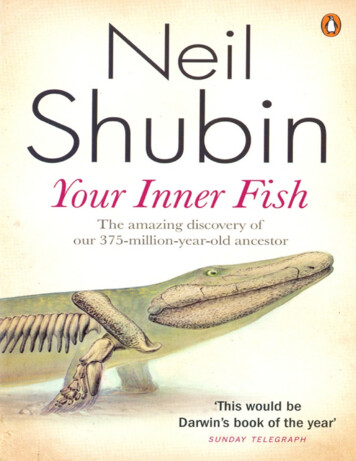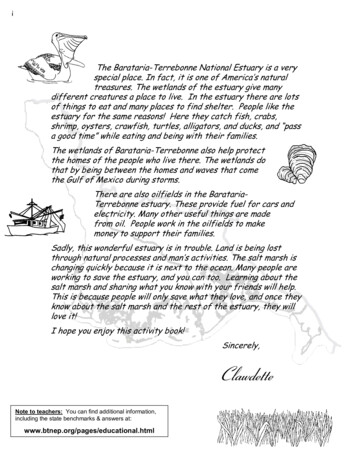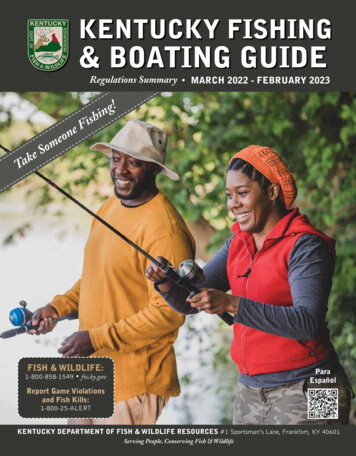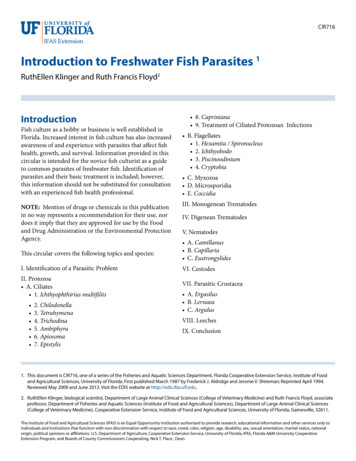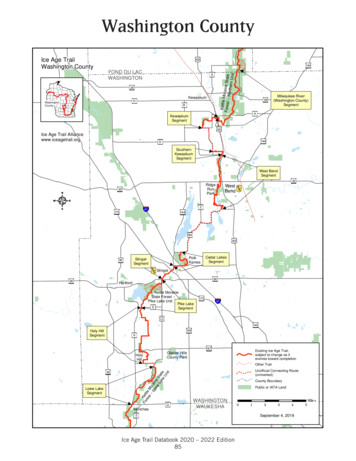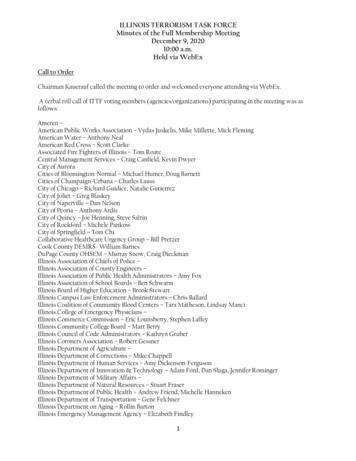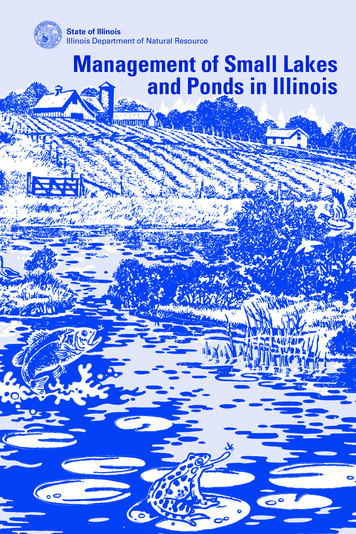
Transcription
State of IllinoisIllinois Department of Natural ResourceManagement of Small Lakesand Ponds in Illinois
“There is certainly something inangling – that tends to producea gentleness of spirit and a pureserenity of mind”Washington IrvingForwardThe purpose of this booklet is to inform the public onthe proper management of ponds, lakes, and impoundments. The term "pond" is used in the bookletto refer to all ponds, lakes or impoundments.The Illinois Department of Natural Resources receives Federal financial assistance from the U.S. Fish and WildlifeService. Under Title VI of the 1964 Civil Rights Act, Section 504 of the Rehabilitation Act of 1973, Title II of theAmericans with Disabilities Act of 1990, the Age Discrimination Act of 1975, and Title IX of the Education Amendments Act of 1972, and the U.S. Department of the Interior prohibits discrimination on the basis of race, color, national origin, age, sex, or disability. If you believe that you have been discriminated against in any program,activity, or facility, or if you need more information, please write to:Chief, Public Civil RightsOffice of Civil Rights, U.S. Department of the Interior1849 C Street, NW, Washington, D.C. 20240Equal opportunity to participate in programs of the Illinois Department of Natural Resources (IDNR)and those funded by the U.S. Fish and Wildlife Service and other agencies is available to all individualsregardless of race, sex, national origin, disability, age, religion or other non-merit factors. If youbelieve you have been discriminated against, contact the funding sources civil rights office and/or theEqual Employment Opportunity Officer, IDNR, One Natural Resources Way, Springfield, IL 62702-1271;217/785-0067; TTY 217/782-9175.Printed by the Authority of the State of Illinois; printed on recycled paper.IOCI 17-0141 DNR 023 – 2M – 01/17
Managementof Small Lakesand Pondsin IllinoisThird EditionRevised 2017Illinois Department of Natural ResourcesDivision of This publication can also be found online in PDF format athttp://ifishillinois.org/publications/Lake Management.pdf1
TABLE OF CONTENTSIntroduction . . . . . . . . . . . . . . . . . . . . . . . . . . . . . . . . . . . . . . . . . . . . . . . . . . . . . . . . . . . . 4The Pond Itself . . . . . . . . . . . . . . . . . . . . . . . . . . . . . . . . . . . . . . . . . . . . . . . . . . . . . . . . . 6Brush Removal . . . . . . . . . . . . . . . . . . . . . . . . . . . . . . . . . . . . . . . . . . . . . . . . . . . . . 6Pond Construction . . . . . . . . . . . . . . . . . . . . . . . . . . . . . . . . . . . . . . . . . . . . . . . . . . 6The Water . . . . . . . . . . . . . . . . . . . . . . . . . . . . . . . . . . . . . . . . . . . . . . . . . . . . . . . . . 8The Food Chain . . . . . . . . . . . . . . . . . . . . . . . . . . . . . . . . . . . . . . . . . . . . . . . . . . . . . 9Fish Stocking . . . . . . . . . . . . . . . . . . . . . . . . . . . . . . . . . . . . . . . . . . . . . . . . . . . . . . . . . . 10When and How to Fish the Pond . . . . . . . . . . . . . . . . . . . . . . . . . . . . . . . . . . . . . . . . . 15Catching Fish . . . . . . . . . . . . . . . . . . . . . . . . . . . . . . . . . . . . . . . . . . . . . . . . . . . . . . . . . . 18Managing The Pond . . . . . . . . . . . . . . . . . . . . . . . . . . . . . . . . . . . . . . . . . . . . . . . . . . . . 21Watershed Management . . . . . . . . . . . . . . . . . . . . . . . . . . . . . . . . . . . . . . . . . . . 21Aquatic Vegetation Control . . . . . . . . . . . . . . . . . . . . . . . . . . . . . . . . . . . . . . . . . 22Harvesting and Controlling Bluegills . . . . . . . . . . . . . . . . . . . . . . . . . . . . . . . . . . 26Predator Control . . . . . . . . . . . . . . . . . . . . . . . . . . . . . . . . . . . . . . . . . . . . . . . . . . . 27Fish Toxicants . . . . . . . . . . . . . . . . . . . . . . . . . . . . . . . . . . . . . . . . . . . . . . . . . . . . . 27Water Level Fluctuations . . . . . . . . . . . . . . . . . . . . . . . . . . . . . . . . . . . . . . . . . . . 27Fertilization . . . . . . . . . . . . . . . . . . . . . . . . . . . . . . . . . . . . . . . . . . . . . . . . . . . . . . . 27Feeding Fish . . . . . . . . . . . . . . . . . . . . . . . . . . . . . . . . . . . . . . . . . . . . . . . . . . . . . . 28Determining the Condition of a Fish Population . . . . . . . . . . . . . . . . . . . . . . . . 30Correcting Poor Fishing . . . . . . . . . . . . . . . . . . . . . . . . . . . . . . . . . . . . . . . . . . . . . . . . . 31Draining . . . . . . . . . . . . . . . . . . . . . . . . . . . . . . . . . . . . . . . . . . . . . . . . . . . . . . . . . . 31Chemical Treatments . . . . . . . . . . . . . . . . . . . . . . . . . . . . . . . . . . . . . . . . . . . . . . . 31Pond Problems . . . . . . . . . . . . . . . . . . . . . . . . . . . . . . . . . . . . . . . . . . . . . . . . . . . . . . . . 35Fish That Can Ruin Fishing . . . . . . . . . . . . . . . . . . . . . . . . . . . . . . . . . . . . . . . . . . 35Muddy Water . . . . . . . . . . . . . . . . . . . . . . . . . . . . . . . . . . . . . . . . . . . . . . . . . . . . . 36Muskrats . . . . . . . . . . . . . . . . . . . . . . . . . . . . . . . . . . . . . . . . . . . . . . . . . . . . . . . . . 36Leeches . . . . . . . . . . . . . . . . . . . . . . . . . . . . . . . . . . . . . . . . . . . . . . . . . . . . . . . . . . 37Swimmer's Itch . . . . . . . . . . . . . . . . . . . . . . . . . . . . . . . . . . . . . . . . . . . . . . . . . . . . 38Fish Kills . . . . . . . . . . . . . . . . . . . . . . . . . . . . . . . . . . . . . . . . . . . . . . . . . . . . . . . . . . 392
Fish Diseases . . . . . . . . . . . . . . . . . . . . . . . . . . . . . . . . . . . . . . . . . . . . . . . . . . . . . . . . . 41Worm Parasites . . . . . . . . . . . . . . . . . . . . . . . . . . . . . . . . . . . . . . . . . . . . . . . . . . . 42Leeches . . . . . . . . . . . . . . . . . . . . . . . . . . . . . . . . . . . . . . . . . . . . . . . . . . . . . . . . . . 43Crustaceans . . . . . . . . . . . . . . . . . . . . . . . . . . . . . . . . . . . . . . . . . . . . . . . . . . . . . . 43Fish Lice . . . . . . . . . . . . . . . . . . . . . . . . . . . . . . . . . . . . . . . . . . . . . . . . . . . . . . . . . . 43Gill Lice . . . . . . . . . . . . . . . . . . . . . . . . . . . . . . . . . . . . . . . . . . . . . . . . . . . . . . . . . . . 43Fungus . . . . . . . . . . . . . . . . . . . . . . . . . . . . . . . . . . . . . . . . . . . . . . . . . . . . . . . . . . . 43Protozoa . . . . . . . . . . . . . . . . . . . . . . . . . . . . . . . . . . . . . . . . . . . . . . . . . . . . . . . . . . 44Bacteria . . . . . . . . . . . . . . . . . . . . . . . . . . . . . . . . . . . . . . . . . . . . . . . . . . . . . . . . . . 44Viruses . . . . . . . . . . . . . . . . . . . . . . . . . . . . . . . . . . . . . . . . . . . . . . . . . . . . . . . . . . . 44Fish Life Histories . . . . . . . . . . . . . . . . . . . . . . . . . . . . . . . . . . . . . . . . . . . . . . . . . . . . . . 45Largemouth Bass . . . . . . . . . . . . . . . . . . . . . . . . . . . . . . . . . . . . . . . . . . . . . . . . . . 45Bluegill . . . . . . . . . . . . . . . . . . . . . . . . . . . . . . . . . . . . . . . . . . . . . . . . . . . . . . . . . . . 47Redear Sunfish . . . . . . . . . . . . . . . . . . . . . . . . . . . . . . . . . . . . . . . . . . . . . . . . . . . . 49Channel Catfish . . . . . . . . . . . . . . . . . . . . . . . . . . . . . . . . . . . . . . . . . . . . . . . . . . . . 50Hybrid Sunfish . . . . . . . . . . . . . . . . . . . . . . . . . . . . . . . . . . . . . . . . . . . . . . . . . . . . . 51Crappie . . . . . . . . . . . . . . . . . . . . . . . . . . . . . . . . . . . . . . . . . . . . . . . . . . . . . . . . . . . 53Yellow Perch . . . . . . . . . . . . . . . . . . . . . . . . . . . . . . . . . . . . . . . . . . . . . . . . . . . . . . 54Walleye . . . . . . . . . . . . . . . . . . . . . . . . . . . . . . . . . . . . . . . . . . . . . . . . . . . . . . . . . . 55Northern Pike . . . . . . . . . . . . . . . . . . . . . . . . . . . . . . . . . . . . . . . . . . . . . . . . . . . . . 56Muskellunge . . . . . . . . . . . . . . . . . . . . . . . . . . . . . . . . . . . . . . . . . . . . . . . . . . . . . . 57Rainbow Trout . . . . . . . . . . . . . . . . . . . . . . . . . . . . . . . . . . . . . . . . . . . . . . . . . . . . . 59VHS Regulations . . . . . . . . . . . . . . . . . . . . . . . . . . . . . . . . . . . . . . . . . . . . . . . . . . . . . . . 60Cooking Your Catch . . . . . . . . . . . . . . . . . . . . . . . . . . . . . . . . . . . . . . . . . . . . . . . . . . . . 61Using The Little Pond . . . . . . . . . . . . . . . . . . . . . . . . . . . . . . . . . . . . . . . . . . . . . . . . . . . 66Pond Safety . . . . . . . . . . . . . . . . . . . . . . . . . . . . . . . . . . . . . . . . . . . . . . . . . . . . . . . 66Fish Fact and Fallacies . . . . . . . . . . . . . . . . . . . . . . . . . . . . . . . . . . . . . . . . . . . . . . . . . 68Illinois Department of Natural Resources Offices . . . . . . . . . . . . . . . . . . . . . . . . . . 72IFishIllinois Website . . . . . . . . . . . . . . . . . . . . . . . . . . . . . . . . . . . . . . . . . . . . . . . . . . . . 74Be a Hero, Transport Zero . . . . . . . . . . . . . . . . . . . . . . . . . . . . . . . . . . . . . . . . . . . . . . . 753
INTRODUCTIONBy themselves, ponds may not look like much, but counted in the tens of thousands,these waters add up to a lot of fishing. In Illinois over 500 new ponds are being builteach year. There are currently over 90,000 ponds in Illinois ranging from 0.1 acres andgreater. The majority of these are not managed for fishing. They would be, if their owners knew what they were missing.Wise anglers enjoy good ponds, for they mean close-to-home action with big bass, andstringers of fat, fighting bluegills. At a time when good fishing is so highly prized, a goodIllinois pond is the answer to a fisherman's prayer. Whether that angler is a freckled kidor a crusty old bass specialist, a good fishing pond means wonderful sport fishing notsoon to be forgotten.That's what this booklet is all about-making your pond a good place to fish and keeping it that way.Good luck, and tight lines!4
THE POND ITSELFFish, like all other animals, need suitable shelter and food for survival and reproduction.However, not all ponds can support game fish populations. To produce and maintaingood sport fishing, the pond must be managed. Good pond management begins withproper shape and depth (pond design) and proper living conditions (water quality) withinthat pond.Proper construction and maintenance of the dam and spillway are essential. The dammust be built so that it will not wash out or develop leaks. The spillway should be designedto handle excessive amounts of water during heavy rainfall. Persons wishing to construct a pond should contact the county office of the U.S. Natural Resources Conservation Service for assistance.The ideal pond should be at least 1 acre in size when full. Smaller ponds are difficult tomanage for any length of time. Their fish populations tend to be unstable and unpredictable. Excessive aquatic plants can seriously interfere with recreational uses of thepond, and also, can provide too many hiding places for small fish. Summer and winterfish kills occur more frequently in small ponds because they are often shallow. Smallponds can seldom support enough fishing pressure to make management worthwhile.They are likely to dry up or provide marginal habitat during extended periods of below average rainfall.BRUSH REMOVALBefore impounding water in a new pond basin, dense stands of trees and brushshould be removed. Trees and brush in small ponds furnish too much cover forsmall fish. Moderate brush in ponds over two acres is usually not detrimental.POND CONSTRUCTIONA minimum depth of at least 10 (south) to 12 (north) feet should be maintained in onefourth of the pond. Depths which range from 10 to 15 feet are even more desirable.The water along the shoreline should be 3 feet deep to reduce the growth of shallow water plants.5
The watershed of the pond should furnish enough water to keep the pond full throughoutthe year with limited flow over the spillway. For most Illinois ponds the ideal watershedto lake ratio is 10 to 20 acres of watershed per surface acre of water. When the watershedto lake ratio is larger than the recommended 20 to 1, problems may develop such as: turbidity due to siltation, low productivity, dam failure, and sedimentation.A pond drainpipe and valve at least 4 inches in diameter is recommended to permit complete draining of the pond in 1 or 2 weeks. A drainpipe offers several advantages. Thepond's water level can be lowered in the summer or fall (see section on drawdowns) toreduce overpopulations of small fish, to drain the pond when undesirable fish are present, to dredge the pond basin if siltation is excessive, or to permit complete fish harvestin a commercial minnow, crayfish or catfish raising operation.The appearance of the pond can be enhanced by proper landscaping, also benefitingwildlife. A hedge row can be planted around the pond as a fence. Consider using shrubswhich make good hedges, such as gray or silky dogwood, or hazelnut. Shrubs, trees andevergreens can be planted in small clumps around the pond inside the fenced area, butnot within 100 feet of the shoreline. Mixed clumps of shrubs can include gray or silky dogwood, hazelnut or high bush cranberry. Also, clumps of small trees such as WashingtonHawthorn or American plum and evergreens such as white pine, Norway spruce, Douglas-fir or concolor fir can be included. Ornamental plantings can be used to add additional color and variety to the area.The dam, earthen spillway and immediate shoreline should be planted with grasses or agrass and legume mixture, such as brome, timothy and alsike or ladino clover. If burningis planned to be used on the area, a better choice is a prairie grass, such as switchgrass(Cave-in-Rock variety) or little or big bluestem. Woody vegetation should not be plantedor allowed to become established on these areas. Mowing should be delayed until afterAugust 1, since wildlife may use the area to nest.In summary, when ponds are constructed, certain precautions should be taken to helpprevent the growth of excessive aquatic vegetation. The pond should be located in a sitewhere drainage does not permit pollutants to reach the pond. The shoreline edges shouldbe deepened to 3 feet or more at the time of construction. This will help prevent the growthof excessive aquatic vegetation.6
The WaterWith the exception of Lake Michigan, the surface waters of Illinois are classified as“warm water”. These are waters that have a midsummer surface temperature of 70 For higher. Temperature is one of the key factors which governs the lives of fish andregulates the kinds of species which can live in our ponds. The amount of dissolvedgases that water holds varies with the temperature. The warm water of summer holdsmuch less oxygen than cold winter water. Temperature affects fish in many ways,including feeding, growth and spawning. Most warmwater fishes grow faster attemperatures above 70 F and dissolved oxygen content of 5 to 8 parts per million (ppm).Temperature is also one of the principle factors influencing the pond cycle through theyear. At 39 F, water reaches its greatest density and weight. Water warmer or colderthan 39 F is lighter. If not for this fact, life on earth would not exist. If water just kepton getting denser as it got colder until it froze, ice would sink and all bodies of water,including the oceans, would be permanently frozen solid! Fortunately for us, the lightest water of all is ice and it floats.Let us look at the annual temperature cycle of a typical pond. In the spring, just after theice thaws, the coldest water is on top at 32 F and the warmest water is on the bottom,at about 39 F. As the warm breezes of spring begin to blow, the cold surface layers ofwater begin to warm. As they get warmer, they get heavier and sink into the depths ofthe impoundment, replacing the lighter, colder layers beneath. Eventually, all the waterreaches 39 F. Up to this point, there have been layers of water at different temperaturesand densities in the pond, making them difficult to mix. Now that the water is all thesame temperature and density, it mixes easily bringing the water which has been on thebottom all winter to the surface. This is called the spring turnover.Ponds can be thought of as breathing twice a year, once in the spring and once in thefall, breathing out the waste products of respiration produced by aquatic life. Thesewaste products include carbon dioxide, hydrogen sulfide, and other gases. At the sametime, the pond is breathing in new oxygen from the air to replace what was used up. Sothe pond starts the year with its water freshened and a new supply of oxygen from topto bottom.During the summer period, a layering effect called thermal stratification sets up,separating the impoundment into 3 zones of differing temperature and density called theepilimnion, the thermocline, and the hypolimnion. These terms simply mean the upperlake, the transition zone, and the lower lake. The thermocline is a layer in which thetemperature drops rapidly, at a rate of 0.5 F or greater per foot of increasing depth.Most people diving into a pond or lake experience the thermocline. Often, they come tothe surface thinking they dove into a spring!The thermocline ends where the temperature ceases to drop rapidly. Once these layersset up in the summer, they are almost as difficult to mix as oil and water and tend to7
remain stable throughout the warm weather. The upper 2 layers then effectively seal thelower lake off from contact with the atmosphere.In a deep lake (50-60 feet or more), the temperature of the lower layer may remain in thelow 40's during the hottest of summer weather. During this time, the aquatic lifegradually uses up the dissolved oxygen present in the lower lake. In about mid·July,the oxygen is used up entirely. This is why you cannot have trout in your lake over thesummer, even though the temperatures on the bottom are plenty cold enough for them.As fall comes, the warm surface waters of the pond begin to cool off. Being cooler thanthe layers below them, they are also denser. This cooler, denser water sinks, displacingthe lighter, warmer water below. This process breaks up the thermal stratification whichhas been so stable all summer, and the pond takes its second breath of the year, the fallturnover. The deoxygenated water of the lower layer is brought to the surface, whereits oxygen supply is renewed, and all the waste product gases which accumulated inthe lower layer during the summer are expelled to the atmosphere. The process iscomplete when all the water in the pond is once again at 39 F.So the pond begins the winter period as it began the summer period, with its waterfreshened and oxygen from top to bottom. As the air temperatures continue to cool,water colder than 39 F floats on the warmer water below it. This provides a relativelywarm refuge for the fish, frogs and turtles of the impoundment to survive the winter.Believe it or not, our fish would die of what we would call exposure, if they were attemperatures below about 35 F for very long during the winter.The Food ChainLife in a pond is a complex, interlocked chain of plants and animals. The food supply forfish depends upon the presence of plant nutrients (organic matter and minerals)dissolved in the water. These food materials enter the pond as dust carried by winds orwith water runoff from the surrounding lands. Nutrients stimulate the growth of smallaquatic plants called algae. Photosynthesis is the process by which green plants usesunlight, carbon dioxide and water to produce carbohydrates and oxygen. The greenplants grow and multiply serving as food for microscopic animals. These tiny animalsmultiply and become forage for larger animals such as small crustaceans and insectlarvae. Small bluegill, redear sunfish, and young largemouth bass eat these crustaceansand insect larvae. Small fish, crayfish, and insect larvae are consumed by larger fish.Then we eat the fish! Thus, the food chain is completed with continuous links extendingfrom basic plant nutrients to predator fish to us.The ratio of deep water to shallow water in a pond has an important bearing on thetotal weight of fish produced. Shallow water areas produce more food than deep waterareas because greater sunlight penetration to the bottom results in a greater abundanceof plant growth and thus, more available dissolved oxygen.8
FISH STOCkINgPonds in Illinois vary greatly in their fish stocking needs. The owners, managers andusers of these ponds also may differ in their sport fishing objectives, and require a wideselection of stocking options. Therefore, it is important to discuss pond stocking witha District Fisheries Biologist. Visit http://ifishillinois.org/ to find the District FisheriesBiologist for your County.Most Illinois ponds provided habitat that is suited for “warmwater” fish. The warmwaterfish species that are stocked with success are the largemouth bass, bluegill, redear andchannel catfish. The stocking of “cool” and “coldwater” fish as an addition to the basicfish stocking, under the proper conditions and timing, also produce good fishing.Before the fish stocking decision is made, careful analyses of pond characteristics andangler preference must be made. Some of the factors affecting the decision includepond type, size, depth, water chemistry, fertility, existing fish population, expected fishingpressure and harvest, and most importantly, what fish do the fishermen want? Surveysby the Division of Fisheries reveal that the largemouth bass, channel catfish, black andwhite crappies, bluegill and redear sunfish are the most fished for species in the Stateof Illinois.The most widely used and successful stocking combination for ponds in Illinois is thelargemouth bass, channel catfish, bluegill and redear sunfish. These species are popular among fishermen, and are biologically adapted to a wide variety of pond conditions.These species effectively utilize natural and artificial foods, and are compatible withmany other species that might be stocked later. The concept of this stocking combinationis that the bluegill eat small aquatic insects and in turn serve as a food for bass. Thebass control the numbers of small fish so that those remaining grow to size.Crappies, though popular with anglers, are not generally suitable for stocking in small lakesand ponds. Crappies are prolific spawners and produce large numbers of offspringwhich can quickly overpopulate. High numbers of bass, which results in slow growthrates, must be maintained to provide desired rates of predation on crappie.Some pond owners are reluctant to stock bluegill because of their reputation foroverpopulating. The cause for most bluegill problems is traceable to overharvest oflargemouth bass and/or to the overharvest of large bluegill. Redear sunfish, in limitedsituations are substituted for bluegill. In most cases, they are generally stocked incombination with the bluegill at a ratio of 70 percent bluegill to 30 percent redear. Theredear is a southern species and generally doesn’t survive the winter, north of interstate80. Bass and bluegill are sometimes stocked alone if redear and channel catfish arenot desired.Fingerling fish (1 to 3 inches) are recommended for the initial stocking of new or rehabilitated ponds. It is essential that no fish exist in the pond before the initial stocking.The single exception is to stock breeder sized fathead minnows which will create anabundant food supply that will eventually be eliminated by bass. Fathead minnows areavailable from private fish dealers. Other minnow species can cause problems.The recommended initial stocking rate varies for different fish species. It is very important that the proper number of fish be stocked, since this original stocking must supportthe first four to five years of fishing.9
The above pond stocking guide is based on the utilization of natural food and does notconsider artificial feeding which can potentially increase the stocking rates. By initiallystocking the correct numbers of fingerlings, a pond or lake will produce sport fishing inless time than by releasing smaller numbers of adult fish. Stocking a few adult fish in anew pond results in an excessive first spawn and stunted fish. If properly managed,bass, bluegill and redear need only an initial stocking as their natural spawning successis adequate to maintain sufficient numbers. Channel catfish do not normally maintain apopulation by natural reproduction in ponds in the presence of bass and bluegill. Therefore,supplemental stocking of 8 inch or larger channel catfish must be completed to sustain a fishable population.10
After the initial stocking, there are numerous other fish stocking situations that may beused to develop or maintain a sport fishery. However, these more complex stocking options should only be pursued under the supervision of a fisheries biologist. Importantnote: A great deal of money is wasted each year by pond owners stocking the incorrectsize, species or numbers, so contact your District Fisheries Biologist before stocking.Some of these stocking options and examples are as follows:Corrective Stocking - Restoring balance to "unbalanced" fish populations requires thepartial removal of the stunted fish and a corrective stocking of either the predator orprey species. Impoundments with a stunted 7 to 11 inch bass population requireharvesting of part of these small bass and possible stocking of adult bluegill. A stunted3 to 5 inch bluegill population requires the stocking of 50-75, 6 to 8 inch bass per acrefor 3-5 consecutive years. Corrective stocking is an effective fishery management toolwhen applied under the proper situation.Diversification Stocking - Many different physical, chemical and biological conditionsoccur within Illinois ponds. It is usually possible to stock additional fish species todiversify the sport fishery. Most of these newly stocked species compete with theexisting fish population for food and space. This decreases the numbers and totalweight of the existing population. Examples of this type of stocking might include 8 inchwalleye stocked at 10 per acre, 8 to 10 inch muskellunge stocked at 1 per acre, or 6inch hybrid striped bass stocked at 3 to 5 per acre. Maintenance of these non-recruiting populations requires periodic supplemental stockings of non-vulnerable sized fishand is more suited to larger impoundments than small ponds.Food Chain Utilization Stocking - Illinois ponds have complex food chains which servea variety of fish species. In many ponds, parts of this food chain are not used becausecertain fish are absent. Adult redear sunfish, for example, eat freshwater snails and inmany ponds having an abundance of snails, their introduction improves the utilizationof an existing food source. This type of stocking situation requires releasing up to 50 ormore adult fish per acre.Food Chain Improvement Stocking - This type of stocking is done in an attempt to improve the production of an existing or future fish population by increasing and diversifying the food chain. In some cases, the initial growth of bass in a new stocking isdoubled by the introduction of 2 pounds of adult fathead minnows per acre. Threadfinshad are also used with some success in large impoundments to provide an increasedforage base for the larger predator fish. Threadfin shad however, will not overwinter inmost ponds in Illinois where winter water temperatures dip below 45 F for extended periods of time. Stocking freshwater shrimp may also be successful in food-chain improvement.Hybrid Sunfish Stocking - Hybrid sunfish are stocked extensively in small impoundmentsthroughout Illinois with mixed results. They are generally stocked with the idea thatthey do not overpopulate like the bluegill, grow at a faster rate than other sunfishspecies, and are easier to catch.11
Experience with hybrid sunfish revealed several distinct disadvantages. Their majorproblem is an inability to produce enough young to maintain desirable largemouth bassgrowth. Most waters stocked with a combination of largemouth bass and hybrid sunfish develop a stunted bass population along with a virtual disappearance of the hybrids. To maintain the hybrid sunfish population, they must be restocked periodically ata costly 3 to 5 inch size.The bluegill (male) x green sunfish (female) hybrid is the best choice to stock in smallponds less than 1 acre where the fish will be artificially fed and the management objectiveis to produce very large sized panfish. Initial stocking rates for hybrid sunfish varybetween 500 and 1000 fingerling fish per acre. Channel catfish fingerlings, stocked atrates from 100 to 200 per acre, can be included with the hybrid sunfish. In addition, adultfathead minnows can be stocked to provide forage.If artificial food is not to be used, a combination of bluegill x green sunfish hybrids andredear x green sunfish hybrids produce the best results. A lower stocking rate is suggestedfor the non-fed hybrid sunfish populations. As with any hybrid sunfish, a periodic stockingis required to sustain their population. Hybrid sunfish have reduced growth potentialwhen stocked in the presence of existing non-hybrid sunfish populations or in combinationwith other species.Seasonal Trout Stocking - Because of the lower water temperatures in ''warm water"impoundments during the fall, winter and spring seasons, it is possible to stock (10 inchor larger) rainbow trout for the creation of a unique "coldwater" sport fishery. In Illinois,rainbow trout live in mo
lake, the transition zone, and the lower lake. The thermocline is a layer in which the temperature drops rapidly, at a rate of 0.5 F or greater per foot of increasing depth. Most people diving into a pond or lake experience the thermocline. Of
